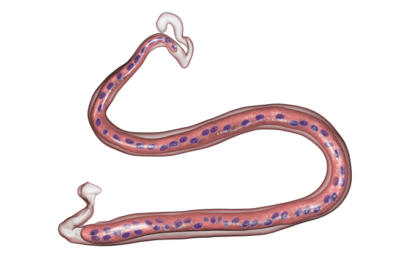Wolbachia: The mosquito manipulator
Posted on November 8, 2018 by Laura Cox
Using mosquitoes infected with bacteria sounds like a strange way to prevent the spread of disease, but that is exactly how scientists have been making headlines in Australia, Florida and Brazil. In an effort to combat dengue fever and Zika virus, thousands of mosquitoes are being intentionally infected with a bacterium called Wolbachia and released around the world.
First identified in 1923, Wolbachia is a highly-prevalent genus of bacteria, believed to infect over 40% of insects. It is an endosymbiotic bacterium, meaning it lives within the host and contributes to host functions. In most cases, endosymbionts have mutuallybeneficial relationships with the host organism, but some of their effects can also be negative.

- Brugia malayi, a roundworm nematode that causes filariasis
In the case of Wolbachia, this endosymbiosis depends on the insect it is infecting. For example, in filarial nematodes like Brugia malayi - the parasitic worm that causes filariasis, or elephantitis - Wolbachia is a strict mutualist; both worm host and bacterium benefit from the relationship.
In mosquitoes, this relationship is more complex depending on the sex of the host. The bacterium prefers female hosts and as a result, Wolbachia is hostile towards male hosts and can even go as far as to manipulate gender.
Sex selector:
Wolbachia can only be transmitted to other insect hosts from females. To drive its own spread and survival, the bacteria hijacks the mosquito reproductive system to increase numbers females in mosquito populations.
Wolbachia uses a variety of methods to reduce males in insect populations, including eliminating male offspring and preventing successful mating with uninfected males. In fact, the bacteria even go as far as to manipulate male insects to have female characteristics; a process known as feminization.
Viral protector:
In order to survive Wolbachia needs a healthy host; the bacteria will defend their host from viral invaders. In particular, they protect against RNA viruses including arboviruses like Zika, dengue and chikungunya.
To manipulate this protective feature, scientists have been able to successfully introduce Wolbachia into the mosquito species Aedes aegypti. Wolbachia does not usually infect A. aegypti meaning it is a major vector of a number of important human diseases. When infected with Wolbachia, rates of viral transmission are reduced and this technique of disease control has already proven effective in Australia.
Behaviour changer:
During infection, Wolbachia are concentrated in the somatic cells (the cells that aid reproduction) and the nervous system. These are the two areas that the bacteria have the greatest effects on their host; by controlling reproduction and manipulating behaviour.
Insects infected with Wolbachia have been observed to participate less in risky activities, even if said activities are essential for survival. For example, mosquitoes infected with Wolbachia are less likely to feed on animal blood, one of their more high-risk behaviours. This is thought to help extend their lives and give Wolbachia a chance to spread to other mosquitoes in the population.
Scientists have only scratched the surface in understanding how Wolbachia’s unique functions can be used to help human health, but there is still a lot to learn from these pervasive microbes. Scientists are currently investigating how Wolbachia prevents infection from arboviruses, with hopes these mechanisms can be applied to further reduce viral transmission in high-burden areas.

